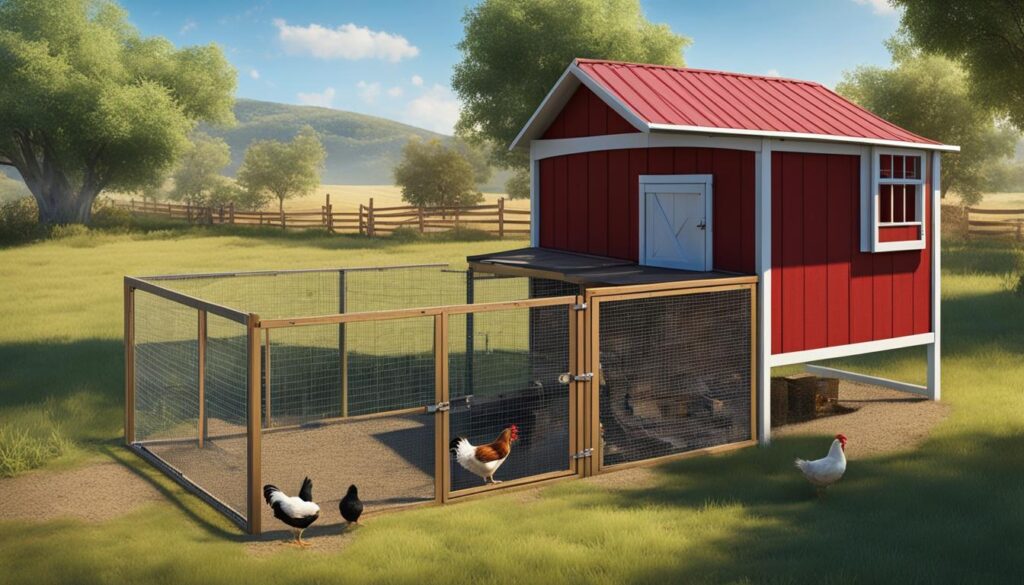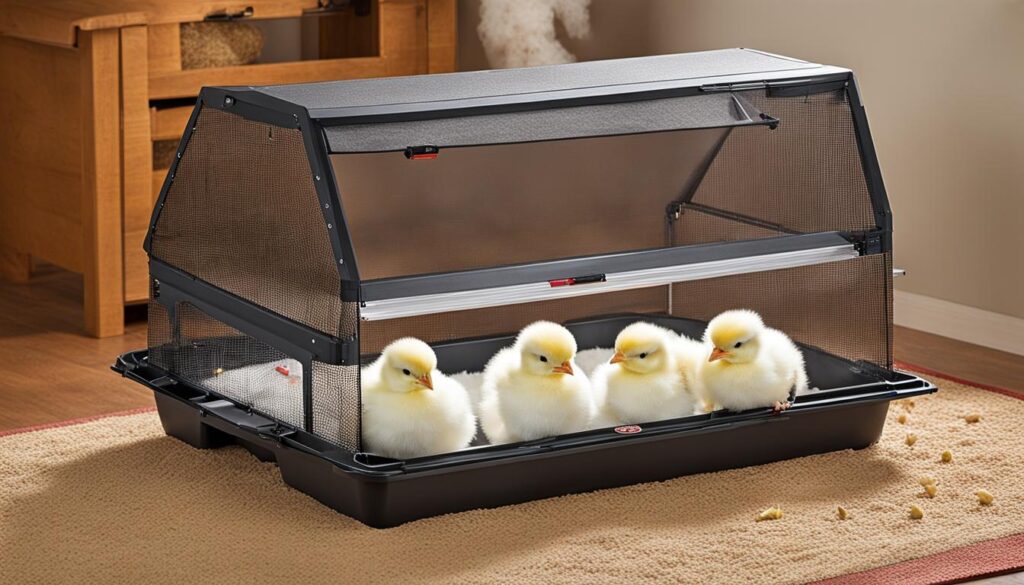As a hobby farmer, I’ve been greeted by the gentle cooing and sometimes frantic chirping of chicks each morning. It’s a sound that holds both charm and challenge; a reminder of the lively presence these small beings add to our lives. Silencing chirps isn’t about dampening their spirits but understanding and attending to the needs of our quiet chicks to ensure they remain content feathered friends.
In the journey of backyard chick care, recognizing what makes a chick vocalize incessantly is the first step toward nurturing a tranquil coop. Through patience and keen observation, I’ve come to realize that the key to a peaceful barnyard chorus lies in the happiness and comfort of each peeping inhabitant.
Key Takeaways
- Understanding the different chirps can help identify your chicks’ needs.
- Creating a soothing environment plays a significant role in silencing chirps.
- Establishing a properly managed brooder is essential for content feathered friends.
- Monitoring and addressing changes in chirping patterns can improve overall chick health.
- Feeding and hydration are key to a peaceful flock.
- Strategic adjustments to temperature and bedding can help reduce noise levels.
Understanding Why Chicks Chirp
As a hobby farmer, I’ve always been fascinated with the soft murmurs and emphatic chirps emanating from my brood of chicks. These sounds are not just noise; they are a form of communication that, when interpreted correctly, reveal much about the well-being and needs of these young creatures. Let’s delve into the significance of these vocalizations and what they indicate.
The Language of Chicks: Decoding the Chirps
Learning to understand why do chicks chirp has been a journey of careful observation and research. Interpreting chick chirps isn’t just for bonding, but a practical way to ensure their health and safety. When a chick emits a series of soft, rhythmic peeps, it’s likely expressing contentment. In contrast, loud and persistent chirping could signify discomfort or distress, alerting me to investigate further.
Common Causes of Excessive Chirping in Chicks
- Hunger or Thirst: A chick’s chirp can often indicate a need for food or water.
- Temperature Regulation: Chicks that are either too cold or too hot may chirp to communicate their discomfort.
- Illness: Subtle changes in the frequency or tone of chirps can suggest underlying health issues.
Chirping as an Indicator of Health and Comfort
Chicks use their voices as a barometer of their overall well-being, and so chick health indicators are often verbal. A change in the chirps, perhaps suddenly faint or agonized, has guided me to detect health concerns early on, ensuring that prompt and appropriate care is provided to keep my flock healthy and thriving.
Here’s a breakdown of various causes of chirping I’ve noted, along with observations that have proven instrumental in my care for the fledgling chickens:
| Chirp Sound | Possible Cause | My Action |
|---|---|---|
| Soft, rhythmic peeping | Contentment | Ensure conditions remain steady |
| Loud, repetitive chirping | Discomfort (temperature/hunger) | Adjust brooder temperature, check food and water |
| High-pitched, distressed chirps | Illness or injury | Inspect chick, consider veterinary advice |
| Continuous, plaintive chirps | Loneliness or fear | Provide comfort, check for predators or environmental stressors |
Dissecting the symphony of peeps and chirps isn’t just heartening as a caretaker; it’s a critical skill for maintaining a harmonious and healthy brood. As my chicks grow, their chirps evolve, but the essence of our communication—their needs echoing through their vocalizations—remains a treasured aspect of our daily lives.
Creating a Comfortable Environment for Your Chicks
As a backyard poultry enthusiast, my quest for nurturing comfortable chicks has led me to realize the profound influence of their living conditions. Achieving optimal brooder conditions is not just about replicating a hen’s warmth—it’s about cultivating a haven that promotes growth and contentment.
Fostering the right backyard chick setup is critical, and I’ve seen firsthand how it quells the chatter and encourages tranquility among the peeps. Let’s walk through the essentials of creating that perfect brooding environment.
- Brooder Temperature: Maintain a steady heat gradient, allowing chicks to self-regulate their comfort.
- Space Requirements: Ensure there’s ample room for exploration and rest to prevent peeping induced by overcrowding.
- Bedding: Use absorbent materials that are changed regularly to keep the brooder clean and dry.
- Accessibility: Food and water should always be within reach to satisfy their needs promptly.
- Security: A secure and predator-proof brooder space keeps stress levels down and chicks chirping happily.
Alongside these guiding points, here’s a detailed table that breaks down the elements that contribute to a serene brooding environment:
| Element | Description | Impact on Chicks |
|---|---|---|
| Temperature | A warm and consistent heat source, especially critical in the first few weeks of life. | Prevents distress calls that are often a response to feeling cold. |
| Space | Minimum of 2 square feet per chick to avoid overcrowding. | Reduces pecking and the stress-induced peeping associated with tight quarters. |
| Bedding | Pine shavings or straw, replaced frequently to maintain cleanliness. | Supports hygiene and comfort, leading to less unrest and chirping. |
| Feeding Station | Feeder design that minimizes spillage and is easy to access. | Ensures consistent nourishment, reducing hunger-induced noise. |
| Water Source | Shallow waterers to prevent drowning, yet always available and clean. | Hydration without struggle or stress keeps chicks quiescent. |
| Security | Enclosure that safeguards against predators and environmental elements. | Boosts feelings of safety, resulting in a more relaxed flock. |

By carefully crafting the brooder to meet these benchmarks, we edge closer to the idyllic chorus of quietly contented chicks. The transformation within the brooding environment when these conditions are met is not just remarkable—it is profoundly rewarding.
How to Make a Chick Stop Chirping
Adding to my flock’s contentment, and consequently ending the relentless soundtrack of chirps, has been a journey of tweaks and discoveries. Each revelation has brought a quiet calm to my backyard brood. Here, I’ll share valuable insights to help you silence the chirps with brooder adjustments, chick nutrition, chick hydration, and the right chick bedding for a happy, healthy flock.
Adjusting the Brooder Temperature
Chicks vocalize discomfort when the temperature is not quite right, and it’s up to us to listen. I’ve learned that achieving the perfect warmth is akin to turning a dial until you hear the ‘click’ of silence. Below are the temperature ranges that have worked like a charm for me:
- First week: 95 degrees Fahrenheit—decrease by 5 degrees each subsequent week
- Maintain a cooler area in the brooder for chicks to self-regulate
- Watch for signs like huddling (cold) or panting (hot) and adjust accordingly
Ensuring Adequate Nutrition and Hydration
Just like us, our chicks’ chirping can be a sign of hunger or thirst. Perfecting chick nutrition and ensuring proper chick hydration has quieted down my most boisterous peepers. Here’s the approach:
| Feed Type | Frequency | Notes |
|---|---|---|
| Starter Crumbles | Free access | High in protein to support growth |
| Fresh Water | Always available | Clean and refresh twice a day |
Providing the Right Bedding and Space
The bedding underfoot plays a critical role in chick comfort and, subsequently, in stopping chick chirping. My choice for chick bedding is a layer of pine shavings and straw—absorbent, soft, and easy to clean, crucial for chick health. Spaciousness is equally vital. Ensuring at least 2 square feet per chick to begin with has minimized the noise and maximized contentment as they grow more robust and independent.

Quiet times in the coop are indicative of content chicks. Stopping chick chirping is more than silencing a sound; it’s about listening and making the necessary adjustments for their utmost welfare.
Behavioral Techniques and Tips for Quietening Chicks
The subtle art of rapport with our chicks hinges on patience and a gentle demeanor. My time among these fragile creatures has reinforced a powerful truth: The way we interact with them has profound effects on their noise levels. By engaging in chick behavioral techniques, we cultivate not only a serene environment but also foster chick bonding that is both rewarding and quieting.
Gentle Handling and Bonding Exercises
By integrating gentle handling routines, I’ve observed the power of touch in settling my lively brood. The aim is not to overwhelm them but to instill trust and comfort. Holding them softly, allowing them to perch on my hand, and speaking in quiet, soothing tones have made my chicks less prone to chirp anxiously. These chick bonding exercises need not be complex—a few minutes multiple times a day can have a significant impact.
Using Sound to Calm Your Flock
Complementing the tactile approach, calming chicks through sound has been an equally impressive tool in my quest for tranquility. The introduction of soft music or natural sounds like the gentle hum of a forest or the soft patter of rain does wonders to allay their skittishness. It’s as if such sounds remind them of the overarching embrace of the natural world they are a part of, dialing back their need to voice distress through chirping.
